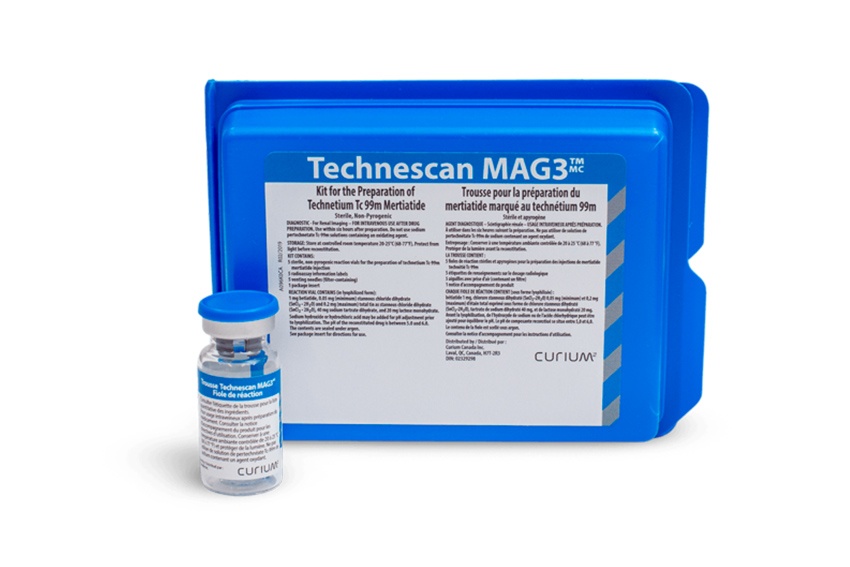

DMSA TECHNESCAN 1 mg KIT FOR RADIOPHARMACEUTICAL PREPARATION

Ask a doctor about a prescription for DMSA TECHNESCAN 1 mg KIT FOR RADIOPHARMACEUTICAL PREPARATION

How to use DMSA TECHNESCAN 1 mg KIT FOR RADIOPHARMACEUTICAL PREPARATION
Introduction
PACKAGE LEAFLET: Information for the patient
DMSA Technescan 1 mg kit for radiopharmaceutical preparation
Succimer
Read all of this leaflet carefully before you start using this medicine because it contains important information for you.
|
Contents of the package leaflet:
- What DMSA Technescan is and what it is used for
- What you need to know before you use DMSA Technescan
- How to use DMSA Technescan
- Possible side effects
- Storage of DMSA Technescan
- Contents of the pack and further information
1. What DMSA Technescan is and what it is used for
This medicine is a radiopharmaceutical for diagnostic use only.
DMSA Technescan contains the active substance succimer. It is used for the preparation of a radioactive injectable solution of technetium (99mTc) succimer.
DMSA Technescan is used in adults and children to examine the kidneys. When injected, this medicine accumulates temporarily in the kidneys. Due to its radioactivity, it can be detected outside the body using a special camera and photographs, known as scans, can be taken. These scans provide valuable information about the structure and/or function of your kidneys. The administration of DMSA Technescan involves receiving a small amount of radioactivity. Your doctor and the nuclear medicine doctor have considered that the clinical benefit you will gain from the procedure with the radiopharmaceutical outweighs the risk due to radiation.
2. What you need to know before you use DMSA Technescan
Do not use DMSA Technescan:
- If you are allergic to succimer or any of the other components of this medicine (listed in section 6), or to any of the components of the radiolabelled product (technetium 99mTc succimer).
Warnings and precautions
Be particularly careful with DMSA Technescan:
- If you are pregnant or think you may be pregnant.
- If you are breast-feeding
- If you have kidney disease.
Talk to your nuclear medicine doctor if any of the above applies to you. This medicine may not be suitable for you. Your nuclear medicine doctor will advise you.
Before administration of DMSA Technescan, you must
- Drink plenty of water before starting the procedure to urinate frequently during the first hours after its completion.
Children and adolescents
Tell your nuclear medicine doctor if you are under 18 years old.
Other medicines and DMSA Technescan
Tell your nuclear medicine doctor if you are using, have recently used or might use any other medicines, including those obtained without a prescription, as they may interfere with the interpretation of the images.
Your nuclear medicine doctor/doctor may advise you to stop taking the following medicines before the procedure with DMSA Technescan:
- ammonium chloride, (ammonium salt, a substance present in some cough medicines and in licorice juice)
- sodium bicarbonate, (medicine given to reduce blood and/or urine acidity)
- mannitol, (diuretic medicine that helps you produce more urine and eliminate salt and excess water from the body)
- some antihypertensive medicinesto treat high blood pressure (so-called ACE inhibitors, such as captopril)
Some cancer medicines (methotrexate, cyclophosphamide, vincristine) may also influence or be influenced by DMSA Technescan.
Pregnancy and breast-feeding
If you are pregnant or breast-feeding, think you may be pregnant or are planning to have a baby, ask your nuclear medicine doctor for advice before using this medicine.
You must inform the nuclear medicine doctor beforeadministration of DMSA Technescan if there is any possibility that you may be pregnant, if you have a delayed period or if you are breast-feeding.
In case of doubt, it is important that you consult your nuclear medicine doctor who is supervising the procedure.
If you are pregnant
The nuclear medicine doctor will onlygive you DMSA Technescan during pregnancy if the expected benefit outweighs the risk.
If you are breast-feeding
Ask your nuclear medicine doctor if you are breast-feeding as they may delaytreatment until breast-feeding has stopped. They may also ask you to interrupt breast-feeding for a short periodand discard this milk during this period, until the radioactivity is no longer in your body. Please ask your nuclear medicine doctor when you can restart breast-feeding.
You do not need to avoid close contact with your baby after the procedure.
Driving and using machines
It is considered unlikely that DMSA Technescan will affect your ability to drive or use machines.
DMSA Technescan contains sodium
This medicine contains less than 1 mmol of sodium (23 mg) per dose; this is "essentially sodium-free".
3. How to use DMSA Technescan
There are strict rules about the use, handling and disposal of radiopharmaceuticals. DMSA Technescan will only be used in specially controlled areas. This product will only be handled and administered by trained and qualified personnel to use it safely. These people will take special care in the safe use of this product and will inform you of their actions.
The nuclear medicine doctor supervising the procedure will decide on the amount of technetium (99mTc) succimer to be used in your case. This will be the minimum amount necessary to obtain the desired information.
The generally recommended amount to administer to an adult is 30 to 120 MBq(MegaBecquerel, the unit used to express radioactivity).
Use in children and adolescents
In children and adolescents, the amount to be administered will be adjusted according to their body weight.
Administration of DMSA Technescan and performance of the procedure
DMSA Technescan is administered by injection, usually into a vein in the arm.
A single injection is sufficient to perform the procedure that your doctor needs.
After the injection, you will be offered a drink and asked to urinate immediately before starting the procedure.
Duration of the procedure
Scans are usually performed 2 to 3 hours after the injection. Occasionally, they may be delayed until 24 hours after the injection. Your nuclear medicine doctor will inform you about the duration of the procedure.
After administration of DMSA Technescan, you must:
- Urinate frequently to eliminate the product from your body
Your nuclear medicine doctor will inform you if you need to take special precautions after being given this medicine. If you have any doubts, talk to your nuclear medicine doctor.
If you have been given more DMSA Technescan than you should
Overdose is unlikely because you will receive a precisely controlled single dose of DMSA Technescan by the supervising nuclear medicine doctor. However, in case of overdose, you will receive the appropriate treatment. In particular, the nuclear medicine doctor may advise you to drink plenty of water and urinate frequently to eliminate the remains of radioactivity from your body.
If you have any further questions on the use of DMSA Technescan, ask your nuclear medicine doctor who is supervising the procedure.
4. Possible side effects
Like all medicines, this medicine can cause side effects, although not everybody gets them.
Side effects of unknown frequency (cannot be estimated from the available data):
- Allergic reactionswith symptoms such as skin rash, redness or itching, increased sweating, swelling of the eyes, tongue or throat, eye inflammation, cough, difficulty breathing, nausea, vomiting, increased salivation, abdominal pain, redness or low blood pressure.
- Circulatory reactionswith symptoms such as fainting, low blood pressure, headache, dizziness, paleness, feeling of weakness or fatigue
- Reactions at the injection site,with symptoms such as skin rash, swelling or inflammation.
Hospital staff will treat these reactions, if they occur.
This radiopharmaceutical provides low amounts of ionizing radiation associated with a very low risk of cancer and genetic abnormalities.
Reporting of side effects
If you experience any side effects, talk to your doctor or pharmacist, even if they are not listed in this leaflet. You can also report side effects directly via the Spanish Pharmacovigilance System for Human Use Medicines: https://www.notificaram.es. By reporting side effects, you can help provide more information on the safety of this medicine.
5. Storage of DMSA Technescan
You will not need to store this medicine. This medicine is stored under the responsibility of the specialist in suitable premises. The storage of radiopharmaceuticals will be carried out in accordance with national regulations on radioactive materials.
The following information is only for the specialist.
Do not use DMSA Technescan after the expiry date stated on the label after EXP.
6. Contents of the pack and further information
Composition of DMSA Technescan
- The active substance is succimer (or dimercaptosuccinic acid).
One vial contains 1.2 milligrams of succimer
- The other components are: inositol, stannous chloride dihydrate (E512), sodium hydroxide (E524) and hydrochloric acid (E507).
Appearance and pack contents of the product
DMSA Technescan is a kit for radiopharmaceutical preparation intended for use only by healthcare professionals. Before use, the powder in the vial is mixed with a radioactive solution called technetium (99mTc) to form a solution of technetium (99mTc) succimer.
DMSA Technescan is packaged in a 10 ml colourless glass type I vial closed with a bromobutyl rubber stopper and sealed with an aluminium cap.
A pack contains 5 vials.
Marketing authorisation holder and manufacturer:
Marketing authorisation holder:
Curium Pharma Spain S.A.
Avenida Doctor Severo Ochoa, N.º 29
28100, Alcobendas, Madrid
Manufacturer:
Curium Netherlands B.V.
Westerduinweg 3
1755 LE Petten
Netherlands
Date of last revision of this leaflet: November 2023
Detailed information on this medicine is available on the website of the Spanish Agency for Medicines and Health Products (AEMPS) http://www.aemps.gob.es/
This information is intended only for healthcare professionals:
The full technical data sheet for DMSA Technescan is included as a separate document in the product packaging, in order to provide healthcare professionals with further scientific and practical information on the administration and use of this radiopharmaceutical. Please consult the technical data sheet for DMSA Technescan.
- Country of registration
- Active substance
- Prescription requiredYes
- Manufacturer
- This information is for reference only and does not constitute medical advice. Always consult a licensed doctor before taking any medication. Oladoctor is not responsible for medical decisions based on this content.
- Alternatives to DMSA TECHNESCAN 1 mg KIT FOR RADIOPHARMACEUTICAL PREPARATIONDosage form: RADIOPHARMACEUTICAL, VIAL POWDER OR LYOPHILIZED (1 mg of succimer)Active substance: technetium (99mTc) succimerManufacturer: Cis Bio InternationalPrescription requiredDosage form: RADIOPHARMACEUTICAL, 25 mg disodium calcium pentetateActive substance: technetium (99mTc) pentetic acidManufacturer: Curium Pharma Spain S.A.Prescription requiredDosage form: RADIOPHARMACEUTICAL, 1 mgActive substance: technetium (99mTc) mertiatideManufacturer: Medi-Radiopharma Kft.Prescription required
Alternatives to DMSA TECHNESCAN 1 mg KIT FOR RADIOPHARMACEUTICAL PREPARATION in other countries
The best alternatives with the same active ingredient and therapeutic effect.
Alternative to DMSA TECHNESCAN 1 mg KIT FOR RADIOPHARMACEUTICAL PREPARATION in Poland
Online doctors for DMSA TECHNESCAN 1 mg KIT FOR RADIOPHARMACEUTICAL PREPARATION
Discuss dosage, side effects, interactions, contraindications, and prescription renewal for DMSA TECHNESCAN 1 mg KIT FOR RADIOPHARMACEUTICAL PREPARATION – subject to medical assessment and local rules.











